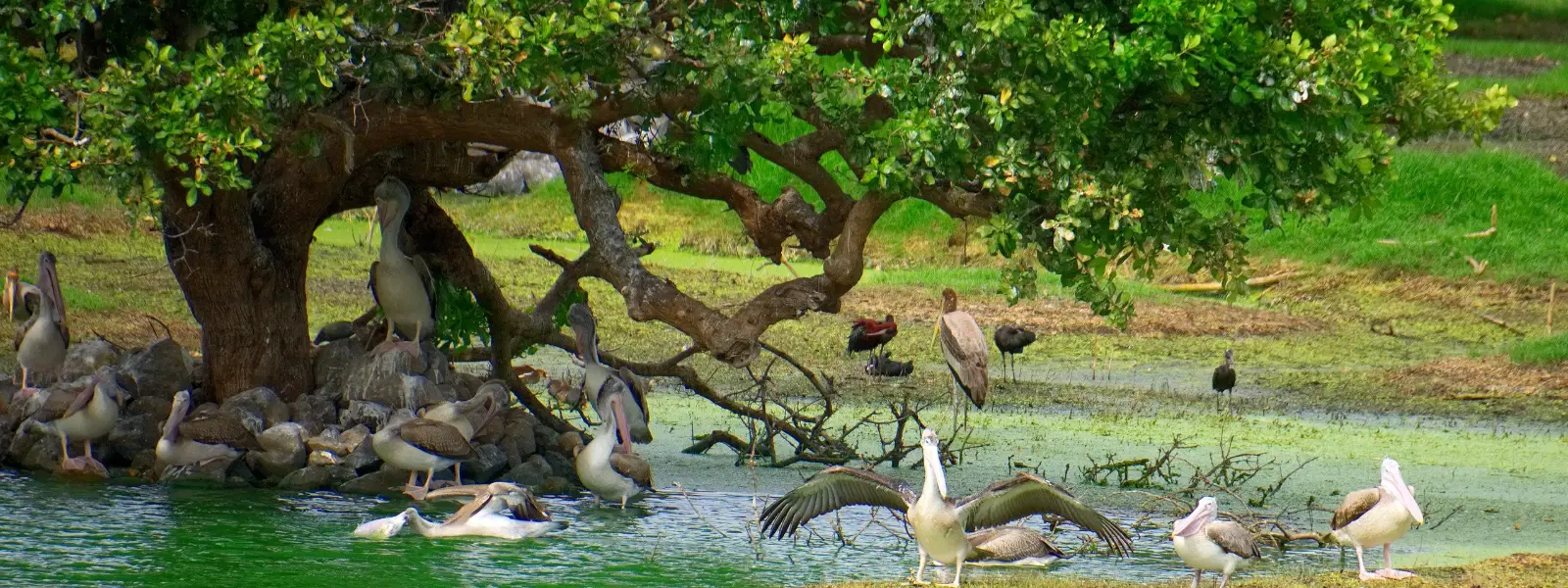
Hotels
•04 min read

West Bengal is not only a canvas of rich culture and history but also a vibrant haven for bird enthusiasts. Did you know that the state hosts some of the most enchanting bird sanctuaries in India, attracting thousands of migratory birds every year? This blog dives into the fascinating world of bird sanctuaries in West Bengal, outlining everything from their defining features to practical tips for an unforgettable birdwatching experience. By reading on, you will learn about key locations, the secrets behind thriving ecosystems, and conservation initiatives, all designed to help you plan a memorable visit.
A bird sanctuary is a protected area dedicated to the conservation of different bird species. In West Bengal, these sanctuaries provide a safe haven where birds can thrive, ensuring that their numbers are sustained against the pressures of urban expansion and environmental changes. Wetlands and nature reserves play a crucial role in the state's biodiversity, serving as natural recruitment zones for both resident and migratory birds.
West Bengal boasts several popular bird sanctuaries that offer visitors a unique glimpse into nature's splendor. For instance, the Chintamoni Kar Bird Sanctuary is celebrated for its serene environment and abundant birdlife. Further north, the Kulik Bird Sanctuary offers panoramic views and is ideal for spotting waterfowl. Meanwhile, Purbasthali Bird Sanctuary, among other nature reserves, is known for its diverse range of species and vast wetlands.
Eco-tourism in West Bengal is greatly enriched by these protected sanctuaries. They not only serve as tourism magnets but also create meaningful opportunities for local communities. By attracting visitors to experience the state’s unspoiled nature reserves and birdwatching spots, these sanctuaries stimulate sustainable economic growth while playing a vital role in the conservation of wildlife.
Beyond well-known sanctuaries, West Bengal is peppered with hidden gems for birdwatchers. National parks and reserved wetlands host an array of bird species in their natural habitats. From the graceful kingfisher darting near water bodies to the majestic heron and egret observed along the riverbanks, each destination promises a unique spectacle. Bird enthusiasts will find that the state’s migratory birds, arriving seasonally, add an extra layer of charm to the experience.
When venturing out for a day of birdwatching, visitors should consider timing and preparation. The months between October and March are ideal, as cooler temperatures and active migratory patterns make spotting birds effortless. Beginners should bring a pair of binoculars, wear comfortable clothing, and respect the local etiquette of keeping noise to a minimum to avoid disturbing the birds.

One of the hallmarks of bird sanctuaries in West Bengal is the spectacular arrival of migratory birds. These travelers, drawn by the abundant food and safe wetlands, include species like the Asian Openbill and the Northern Pintail. Their seasonal presence adds dynamic layers to the local ecosystem, making each visit a unique experience of nature's cyclical wonders.
Protected areas in West Bengal, including numerous nature reserves and wildlife sanctuaries, are central to maintaining the ecological balance. These regions provide a buffer against rapid urban development and environmental degradation, ensuring that bird species continue to thrive in a natural setting. Conservation efforts here are intertwined with community initiatives, supporting both environmental and social sustainability.
Despite the natural beauty, bird sanctuaries in West Bengal face significant challenges. Habitat loss due to urban sprawl, pollution in water bodies, and the ever-increasing impacts of climate change endanger these fragile ecosystems. For example, encroachments near wetland areas have raised concerns among conservationists, prompting calls for stricter management and awareness.
In response to these threats, various government and NGO-led initiatives have taken root across the state. Efforts include launching eco-tourism programs that support the sanctuaries financially while promoting sustainable visitation practices. These programs also work to educate the local community and visitors about the importance of preserving West Bengal’s natural heritage and its diverse bird species.
Planning your visit is straightforward once you know the seasonal patterns. The period from October to March is considered the best time, as migratory birds peak during these months and the cooler weather enhances outdoor exploration. By aligning your visit with these natural cycles, you increase your chances of witnessing the most vibrant displays of bird colors and behaviors.
Reaching these pristine locations is made easier by India's extensive connectivity. Whether traveling by air, train, or road, each major sanctuary in West Bengal is accessible with a little planning. For instance, many sanctuaries are well-linked to nearby towns and cities, although sometimes a short drive or a guided trek may be required to access the more secluded spots. Consider local transport options and regional travel tips when mapping your journey.

Visitors should be aware that some bird sanctuaries, such as Chintamoni Kar Bird Sanctuary, may charge a nominal entry fee. These fees help maintain the sanctuaries and their conservation efforts, making your visit a contributory experience. Always check updated guidelines before your trip and be mindful of responsible tourism practices. It is essential to follow the rules, respecting both the wildlife and the environment.
Did You Know? West Bengal is home to over 500 bird species, including rare migratory birds that travel thousands of kilometers to reach its wetlands every year.
West Bengal has several bird sanctuaries, including Chintamoni Kar Bird Sanctuary, Kulik Bird Sanctuary, and Purbasthali Bird Sanctuary, each offering unique birdwatching experiences.
The ideal time is between October and March, when migratory birds are most active and the weather is pleasant for outdoor activities.
Yes, some sanctuaries, like Chintamoni Kar Bird Sanctuary, have nominal entry fees. It is best to check the specific sanctuary website for updated pricing.
You can spot both resident and migratory birds, including kingfishers, herons, egrets, and rare species like the Asian Openbill and the Northern Pintail.
Absolutely! Bird sanctuaries in West Bengal offer educational and recreational experiences that are perfect for visitors of all ages.
West Bengal's bird sanctuaries offer a window into the rich biodiversity of the region. From unique birdwatching spots and well-preserved wetlands to dedicated conservation efforts, these sanctuaries play a vital role in eco-tourism and wildlife protection. By understanding their significance and planning your visit wisely, you can experience the tranquil beauty and dynamic life of this remarkable ecosystem while embracing sustainable travel practices.